The Beginner’s Guide to Customer Marketing
Customer marketing is the lifecycle strategy that the best companies use to retain loyal customers by delivering on brand values and exceeding expectations every step of the way.
Businesses that budget for an optimized customer experience consistently earn higher revenues. As Marketing Metrics reports, companies are 40-65% more likely to sell to an existing client than a new one. Yes, we all want to put our best foot forward to new customers, but is your brand walking the walk? Or always jumping to the next thing and leaving customers in the lurch?
Our five-step beginner’s guide to customer marketing will help you answer these questions. Supported by industry leading examples, we’ll spend quality time looking at how to craft lifecycle campaigns for websites, landing pages, mobile and email channels.
Next, we’ll discuss how to effectively support these programs by creating value-driven source materials. From here, it’s time to talk about recruiting and segmenting consumer advocacy groups within an effective referral program. Lastly, we’ll bring it home by touching base about how to create lasting relationships with NPS and customer satisfaction surveys.
What is customer marketing?
“Customer experience is now the fifth marketing P that needs to be managed as purposely and carefully as the product, the price, and the promotion.”
-Lisa Macpherson, Hallmark (ClientHeartbeat)
Customer marketing is the strategic group of activities focused upon driving retention, advocacy, loyalty and overall community engagement in current customers. It’s goal is not to acquire new customers, but fortify and maximize the relationships of those already involved with your brand.
This outside-in focus to consumer relations is the perfect way to reduce costly churn. Plus, it’s critical to boosting your company's bottom line.
“65% of a company’s business comes from existing customers, and it costs five times as much to attract a new customer than to keep an existing one satisfied,” says a source at Gartner.
...and…
“Attracting a new customer can cost as much as 15 times more than retaining an existing customer,” says Winning New Business in Construction author, Terry Gillen.
Taking a win-win mentality to growth means moving beyond the meet-and-greet moments with the flashy smile and strong handshake and repeatedly making consumers feel at home in your inner circle.
Essentially, treat customers as you would treat your friends.
As Stephen R. Covey tells us in The 7 Habits of Highly Effective People, we can’t be “efficient” and keep friends. We must “make deposits in their emotional bank accounts”—on their terms—in order to sustain a mutually beneficial, rewarding relationship in the long term.
How to do this?
Create a superior brand experience from inside out.
Let’s now look at the five steps of doing that….
#1 Welcome newcomers and let them know what to expect
You’ll want to make a great first impression with incoming clientele. This begins with a frictionless onboarding experience detailing what’s in store when dealing with your brand.
The onboarding lifecycle email is a critical component of this phase.
It shows you’re trustworthy and predictable, so take this chance to be crystal clear with newbies about what’s coming their way.
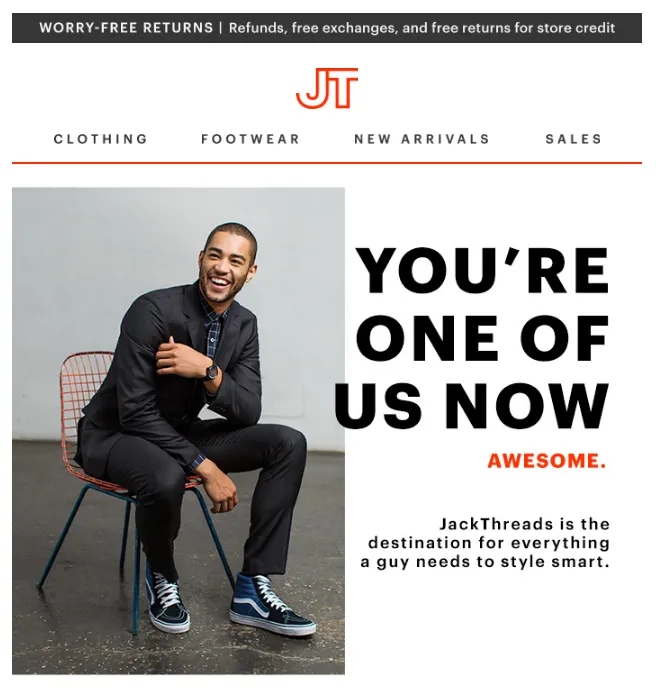
Creating a sense of kinship right away, this Jackthreads welcoming lifecycle email draws viewers in letting them know they’re a part of something bigger. The copy utilizes an informal, friendly tone and wastes no time reminding us that “You’re” a welcome member of a select group. The sharp-dressed guy in the ad is a perfect ambassador: People love to see a friendly face. University research published in the academic journal Neuropsychologia shows that a charming smile activates the part of the brain that processes sensory pleasure and actually rewards you as a viewer.
#2 Be consistent and use personalization
Creating a consistent brand experience is a matter of content and style. After the onboarding process, your brand image lets customers know you’re still with them. If every channel uses a different tone in copy, a new design layout or the content quality fluctuates, your brand can become a chore to keep up with.
Emphasize a fluid and seamless brand experience to retain your best customer, engage with the new and convert with the interested.
Personalize your messaging across every channel to maximize engagement. Consumer psychology is clear: Users want a personalized experience every time. From seeing our names in email subject lines to receiving special swag, the little things are the big things.
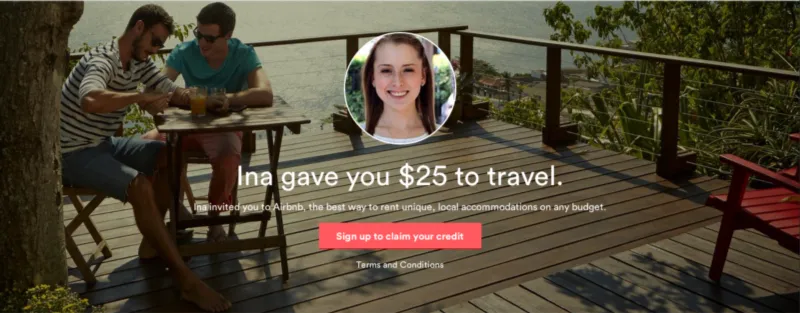
(Source)
International travel brand Airbnb knows how to keep their brand experience intimate and close to home. This personalized landing page uses an alluring hero image to frame a friendly face and a bold, actionable conversion “call to action” (CTA). The design elements are consistent with the rest of the brand's aesthetic and the copy is instantly relevant and straightforward. Optimized referral programs like this are an outstanding way to drive conversions because nothing’s more personal or effective than a friend's recommendation.
#3 Spotlight your best customers
The next step is to promote your customer referral program and effectively recruit customer advocacy groups. To do this, be sure to involve your most engaged customers directly.
Because customer marketing is all about people, vocal brand advocates are effective at providing the social proof that helps take desired actions. Social, loyal users will make your customer marketing campaigns into a simple game of follow the leader. You can build enthusiasm for your brand by reaching out to influencer types who are likely to recruit new followers.
To promote engagement in target user groups, start by segmenting customers. Once you’ve grouped like with like, you can effectively relate to users on a one-to-one basis. To manage your advocacy groupings, try sorting by levels of engagement, spending patterns, geographic region and past referrals.
This will allow you to engage in different conversations with each type of customer. Now you can speak to these individuals more effectively through special offers, personal follow ups and educational content that seems tailored to their exact position. The beauty of optimized referral programs is they complement customer marketing strategies perfectly. Focused upon retention, yet effective at converting new customers simultaneously.
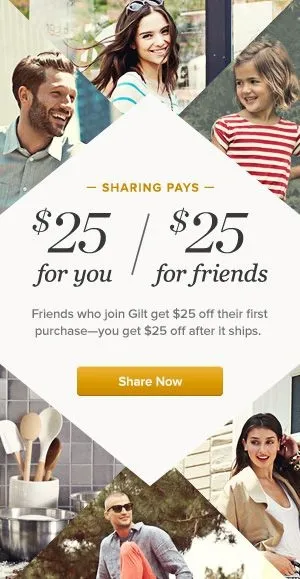
(Source)
Luxury brand Gilt announces referral program rewards via good cheer and reciprocal rewards. Good as gold, this mobile lifecycle message prompts groups leaders to call upon their friends and family. As seen in the ad, “SHARING PAYS” promises clear benefits while the pictures reference bringing a smile on friends’ faces. The $25 values are perfectly sized and centrally located above an action-oriented social share CTA, making it easy to convert.
Interlocking triangle designs effectively highlight how many people can benefit from this mobile referral program. A nice, personalized touch to promote further conversions: the shapes come together into what looks like an envelope.
#4 Stay top of mind
With customer retention a byproduct of customer service, customer engagement is a byproduct of valuable marketing materials. To sustain a working relationship with customers, plan and develop top-notch content you can release on an appropriate schedule for each user group. This is the way to keep your brand in the hearts and mind of users.
Attempt using influencer marketing tactics and pull testimonials from previous customer engagements. Cultivate third party reviews as well, however, brand ambassadors are always your best option: 70% of consumers trust referrals from friends while branded content from websites are a close second, according to Nielsen.
Whether it’s deep linking to blog posts in your website through personalized emails or sponsored research for case studies, don’t skimp on branded content. More often, consumers are looking to people they know for insights on trustworthy brands. Consistently creating value for your audience and framing it with friendship is a surefire way to max out on conversions and sustain engagement.
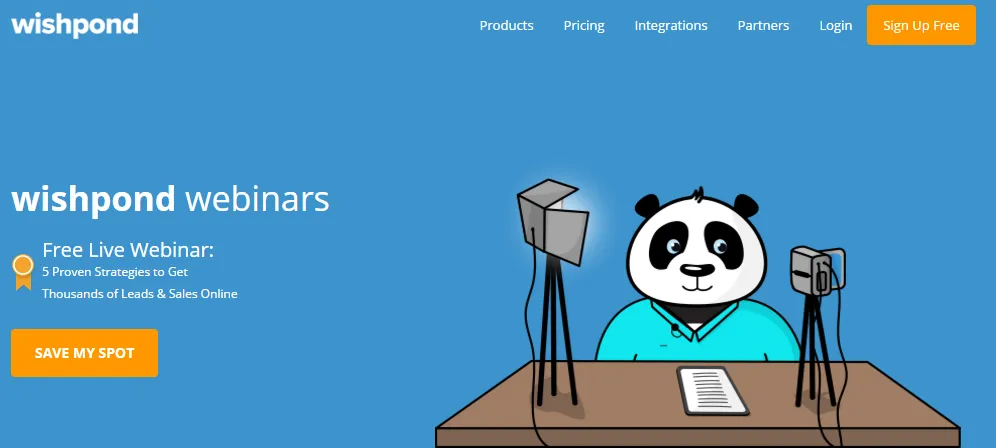
For example, the lead generation team at Wishpond uses their website to offer visitors a great piece of content: a free webinar! Not only can we learn something here, but this is a creative format that moves beyond clicking links and surfing the web. By having face time with the brand, customer satisfaction and brands experience is sure to increase. Implementing a reliable routine of variety for quality content is how premier brands stay close to their core groups.
#5 Stay friendly and keep in touch
Checking on your relationships is always appreciated by customers because it shows you’re actively listening.
How to assess how well you’re faring with consumers?
Calculate your NPS, or Net Promoter Score. NPS measures how likely your customers are to recommend your brand—or competitors brands—to their friends. It’s a metric that directly relates how satisfied your customers are.
“NPS is a leading indicator of future growth. The larger the number of advocates for product, the lower the customer acquisition costs for the company, and the more effective a customer success team will be.”
-Bill Macaitis, CMO of Slack (tomtunguz.com)
Your NPS revolves around two simple questions:
- How likely is it that you would recommend my brand/product/service to a friend or colleague?
- What is the most important reason for your score?
How to achieve these answers? Make time for a simple survey.
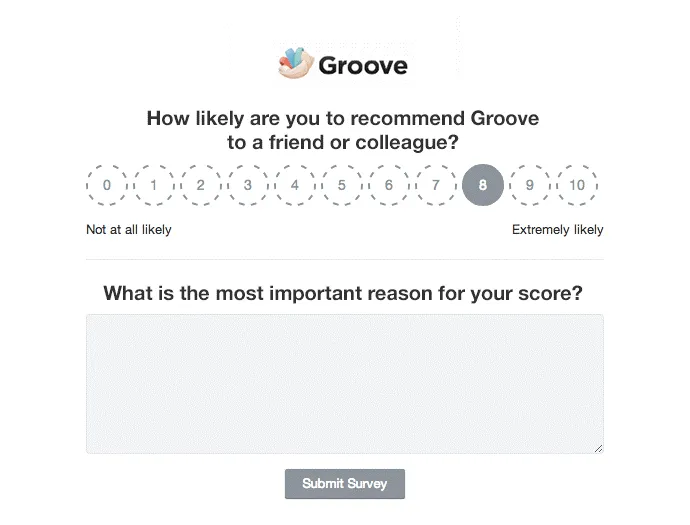
This Groove NPS survey focuses user attention on providing useful feedback and circling their level of satisfaction. Helping customers feel comfortable providing feedback is as much a matter of the survey itself as delivery. How and when to send net promoter surveys effectively can be behavioral or scheduled in regular lifecycles.
Applying insights from consumers from surveys can make or break a customer marketing program, especially when attached to an optimized referral program.
Conclusion
These have been the five guidelines for creating a customer marketing strategy. Nowadays, businesses are rewarded by investing in customer relations consistently. Spending resources in an 80/20 fashion, the brands we looked at today know that they should seek to be of value— and that success follows.
When striving for customer engagement, a win-win mentality can be seen across every channel in the marketing program. Personalized email, webpages and mobile messaging will drive engagement with customers consistently. Be sure to recruit testimonials, case studies and premium quality content to keep your brand relevant and top of mind. Finally, seal the deal with a good NPS score and customer surveys. By repeating this strategy, your customers will love you ... look to revenues for the proof.